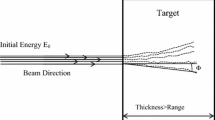Abstract
The dependence of efficiency of a gas-flow proportional counter with respect to the source thickness and α-particle energy was evaluated using the code SRIM. Results for the mass-efficiency curves were evaluated for 209Po and 241Am in a substrate of NaNO3. The results revealed good agreement with a linear and a hyperbolic dependence for low and high thickness sources, respectively. However, some deviations were found for very thin thicknesses, which can be explained by taking into account scattering effects. A function is proposed for predicting the dependence of efficiency with α-particle energy in the range from 4 to 8 MeV.





Similar content being viewed by others
References
Semkow TM, Parekh PP (2001) Principles of gross alpha and beta radioactivity detection in water. Health Phys 81:567–574
Jobbágy V, Wätjen U, Meresova J (2010) Current status of gross alpha/beta activity in water samples: a short overview of methods. J Radioanal Nucl Chem 286:393–399
Martín Sánchez A, Sáenz García G, Jurado Vargas M (2009) Study of the self-absorption for the determination of gross alpha and beta activities in water and soil samples. Appl Radiat Isot 67:817–820
Suarez-Navarro JA, Pujol L, de Pablo MA (2002) Rapid determination of gross alpha-activity in sea water by coprecipitation. J Radioanal Nucl Chem 253:47–52
Parsa B, Obed RN, Nemeth W, Souzzo GP (2005) Determination of gross alpha, Ra-224, Ra-226 and Ra-228 activities in drinking water using a single sample preparation procedure. Health Phys 89:660–666
Jurado Vargas M, Fernández Timón A (2005) Dependence of self-absorption on thickness for thin and thick alpha-particle sources of UO2. Nucl Instrum Methods Phys Res A 548:432–438
Semkow TM, Jeter HW, Parsa B, Parekh PP, Haines DK, Bari A (2005) Modeling of alpha mass-efficiency curve. Nucl Instrum Methods Phys Res A 538:790–800
EPA (1980) EPA method 900.0: gross alpha and gross beta radioactivity in drinking waters. US Environmental Protection Agency, Washington DC
APHA (2005) Standard methods for the examination of water and wastewater, 21st edn. American Public Health Association, Washington DC
ISO 9696 (2007) Water quality: measurement of gross alpha activity in non-saline water-thick source method. International Organization for Standardization, Geneva
Rossi BB, Staub HH (1949) Ionization chambers and counters, Experimental techniques. McGraw-Hill, New York
White PH (1970) Alpha and fission counting of thin foils of fissile material. Nucl Instrum Methods 79:1–12
Jeter HW (1998) An extended-range method for gross alpha-/beta-particle measurement in water samples. Radiact Radiochem 9:16–25
Ziegler JF, Ziegler MD, Biersack JP (2010) SRIM 2010-The stopping and range of ions in matter. Nucl Instrum Methods Phys Res B 268:1818–1823
Jurado Vargas M, Fernández Timón A (2012) Alpha-particle energy distributions from thin sources measured with small solid angles. J Radioanal Nucl Chem 292:571–577
Reza M, Negarestani A, Sohrabi M, Mohammadi S, Afzali D (2012) Parameterization of 241Am and 230Th alpha particle energy in dependence on distance traveled in air. J Radioanal Nucl Chem 293:39–44
Particle Interactions With Matter. http://www.srim.org. Accessed 8 Apr 2014
Arndt MF, West LE (2004) A study of the factors affecting the Gross Alpha Measurement, and a Radiochemical Analysis of some Groundwater Samples from the State of Wisconsin Exhibiting an Elevated Gross Alpha Activity. In: Proceedings 51st Annual Radiobioassay and Radiochemical Measurement Conference. Cincinnati
Semkow TM, Khan AJ, Haines DK, Bari A (2009) Rapid alpha spectrometry of evaporated liquid residues for emergence response. Health Phys 96:432–440
Montaña M, Camacho A, Vallés I, Serrano I (2012) Experimental analysis of the mass efficiency curve for gross alpha activity and morphological study of the residue obtained by the co-precipitation method. Appl Radiat Isot 70:1541–1548
Acknowledgments
Thanks are due to the Gobierno de Extremadura (Projects GRU09011 and GR10160) and Ministerio de Economía y Competitividad (Project TIN2012–35632–C02–02) for financial support. We also thank Dr. T. Semkow for his comments.
Author information
Authors and Affiliations
Corresponding author
Rights and permissions
About this article
Cite this article
Fernández Timón, A., Jurado Vargas, M. & Ziegler, J.F. Application of alpha particle transport to the modelization of efficiency curves in proportional counters. J Radioanal Nucl Chem 302, 297–302 (2014). https://doi.org/10.1007/s10967-014-3205-z
Received:
Published:
Issue Date:
DOI: https://doi.org/10.1007/s10967-014-3205-z




